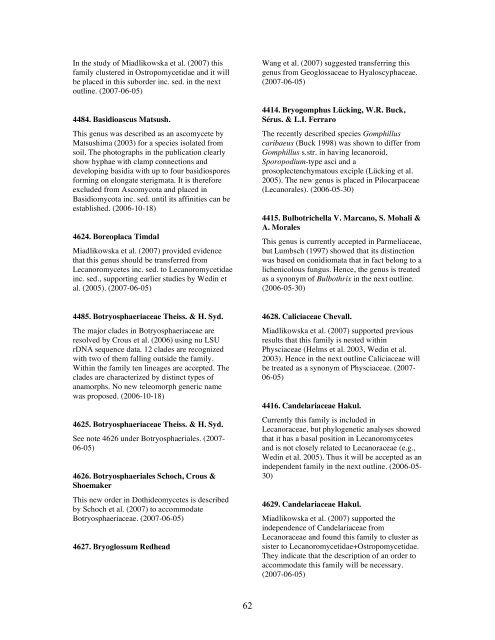Notes on ascomycete systematics. Nos. 4408-4750. Myconet 13: 59
Notes on ascomycete systematics. Nos. 4408-4750. Myconet 13: 59
Notes on ascomycete systematics. Nos. 4408-4750. Myconet 13: 59
You also want an ePaper? Increase the reach of your titles
YUMPU automatically turns print PDFs into web optimized ePapers that Google loves.
In the study of Miadlikowska et al. (2007) this<br />
family clustered in Ostropomycetidae and it will<br />
be placed in this suborder inc. sed. in the next<br />
outline. (2007-06-05)<br />
4484. Basidioascus Matsush.<br />
This genus was described as an <strong>ascomycete</strong> by<br />
Matsushima (2003) for a species isolated from<br />
soil. The photographs in the publicati<strong>on</strong> clearly<br />
show hyphae with clamp c<strong>on</strong>necti<strong>on</strong>s and<br />
developing basidia with up to four basidiospores<br />
forming <strong>on</strong> el<strong>on</strong>gate sterigmata. It is therefore<br />
excluded from Ascomycota and placed in<br />
Basidiomycota inc. sed. until its affinities can be<br />
established. (2006-10-18)<br />
4624. Boreoplaca Timdal<br />
Miadlikowska et al. (2007) provided evidence<br />
that this genus should be transferred from<br />
Lecanoromycetes inc. sed. to Lecanoromycetidae<br />
inc. sed., supporting earlier studies by Wedin et<br />
al. (2005). (2007-06-05)<br />
4485. Botryosphaeriaceae Theiss. & H. Syd.<br />
The major clades in Botryosphaeriaceae are<br />
resolved by Crous et al. (2006) using nu LSU<br />
rDNA sequence data. 12 clades are recognized<br />
with two of them falling outside the family.<br />
Within the family ten lineages are accepted. The<br />
clades are characterized by distinct types of<br />
anamorphs. No new teleomorph generic name<br />
was proposed. (2006-10-18)<br />
4625. Botryosphaeriaceae Theiss. & H. Syd.<br />
See note 4626 under Botryosphaeriales. (2007-<br />
06-05)<br />
4626. Botryosphaeriales Schoch, Crous &<br />
Shoemaker<br />
This new order in Dothideomycetes is described<br />
by Schoch et al. (2007) to accommodate<br />
Botryosphaeriaceae. (2007-06-05)<br />
4627. Bryoglossum Redhead<br />
62<br />
Wang et al. (2007) suggested transferring this<br />
genus from Geoglossaceae to Hyaloscyphaceae.<br />
(2007-06-05)<br />
4414. Bryogomphus Lücking, W.R. Buck,<br />
Sérus. & L.I. Ferraro<br />
The recently described species Gomphillus<br />
caribaeus (Buck 1998) was shown to differ from<br />
Gomphillus s.str. in having lecanoroid,<br />
Sporopodium-type asci and a<br />
prosoplectenchymatous exciple (Lücking et al.<br />
2005). The new genus is placed in Pilocarpaceae<br />
(Lecanorales). (2006-05-30)<br />
4415. Bulbotrichella V. Marcano, S. Mohali &<br />
A. Morales<br />
This genus is currently accepted in Parmeliaceae,<br />
but Lumbsch (1997) showed that its distincti<strong>on</strong><br />
was based <strong>on</strong> c<strong>on</strong>idiomata that in fact bel<strong>on</strong>g to a<br />
lichenicolous fungus. Hence, the genus is treated<br />
as a syn<strong>on</strong>ym of Bulbothrix in the next outline.<br />
(2006-05-30)<br />
4628. Caliciaceae Chevall.<br />
Miadlikowska et al. (2007) supported previous<br />
results that this family is nested within<br />
Physciaceae (Helms et al. 2003, Wedin et al.<br />
2003). Hence in the next outline Caliciaceae will<br />
be treated as a syn<strong>on</strong>ym of Physciaceae. (2007-<br />
06-05)<br />
4416. Candelariaceae Hakul.<br />
Currently this family is included in<br />
Lecanoraceae, but phylogenetic analyses showed<br />
that it has a basal positi<strong>on</strong> in Lecanoromycetes<br />
and is not closely related to Lecanoraceae (e.g.,<br />
Wedin et al. 2005). Thus it will be accepted as an<br />
independent family in the next outline. (2006-05-<br />
30)<br />
4629. Candelariaceae Hakul.<br />
Miadlikowska et al. (2007) supported the<br />
independence of Candelariaceae from<br />
Lecanoraceae and found this family to cluster as<br />
sister to Lecanoromycetidae+Ostropomycetidae.<br />
They indicate that the descripti<strong>on</strong> of an order to<br />
accommodate this family will be necessary.<br />
(2007-06-05)

















